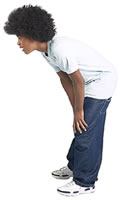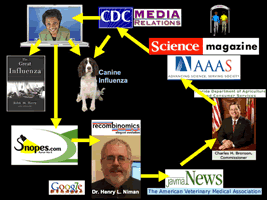 Canine Flu, Bird Flu and Beyond
Canine Flu, Bird Flu and Beyond
 As part of a "reading in the content areas" program, students selected a work of fiction or non-fiction work read.
As part of a "reading in the content areas" program, students selected a work of fiction or non-fiction work read.
It's difficult for Jamal to find a good place to read at home. He's found that the comfortable leather chairs in the library are the perfect place catch up.
After reading The Great Influenza: The Epic Story of the 1918 Pandemic by John M. Barry, Jamal became interested in whether a pandemic like the one in 1918 could strike again. Is the world prepared for this type of disaster? How would a pandemic impact the poorest members of our communities? Is the public health system ready?
The Canine Influenza Epidemic: Fact or Fiction?
 Like most teens, Jamal communicates with family members through email. When he receives an email "forward" from him grandmother in Florida, he generally puts it in the trash. She sends lots of "forwarded messages" including chain emails, prayers, political jokes, and urban legends. While she thinks of these messages as fact, Jamal is much more skeptical. He's also mature enough not to argue with grandma.
Like most teens, Jamal communicates with family members through email. When he receives an email "forward" from him grandmother in Florida, he generally puts it in the trash. She sends lots of "forwarded messages" including chain emails, prayers, political jokes, and urban legends. While she thinks of these messages as fact, Jamal is much more skeptical. He's also mature enough not to argue with grandma.
However one email forward catches his eye. The headline is "The New Canine Influenza". The message states that a virus deadly to dogs was first found in greyhound race dogs and has been spreading in the canine population of the U.S. He wonders if this could be true. His grandmother is clearly concerned about Bailey, the family dog.
Having recently read The Great Influenza: The Epic Story of the 1918 Pandemic by John M. Barry for a science class, Jamal considers whether this could be connected to other recent viruses such as the "bird flu."
Like most teens, Jamal spends lots of time on the Internet. His first stop is Snopes to look up dog flu. He quickly locates a copy of the ominous email and is shocked to find that Snopes indicates the email is True. After reading the background information found by Snopes, he decides to conduct his own investigation to confirm the information in the email.
The message refers to an article at Recombinomics.com, so he checks the reference. Wondering about the credibility of this website, he examines the Founder page and learns that the website is authored by a person with authority. To check his credentials, Jamal googles "Henry L Niman". He finds that Niman is being interviewed by many news and health organizations worldwide on this topic.
The article also mentions AVMA. Googling AVMA brings up the American Veterinary Medical Association. This website contains the JAVMA (Journal of Veterinary Medical Association) News which links to an article titled "Canine influenza virus emerges in Florida." It states that "Known as canine influenza or canine flu, the disease is caused by a highly contagious virus that was recently identified by researchers at the University of Florida College of Veterinary Medicine." Jamal decides to read the press report from the Florida Agriculture and Consumer Services Commissioner titled Bronson Alerts Public to Newly Emerging Canine Flu. The article indicates that the actual report is in the journal Science (30 September 2005).
Unfortunately he doesn't have access to the journal Science, so he logs into his school library to search for the article. He finds that the current issue isn't available online, but it is available in the physical library.
Jamal goes to the journal Science online and wonders about their credibility. The copyright notice indicates that the magazine is published by the American Association for the Advancement of Science. The AAAS website confirms that they are actually associated with this magazine. He has confidence in this article.
The email also mentions the APHIS. He googles APHIS and learns that it's the Animal and Plant Health Inspection Service of the USDA. The website isn't well organized, so he leaves.
Finally, he checks the references provided at the Snopes website from the New York Times and Boston Herald.
Satisfied that people are concerned about this topic, Jamal decides to see what government officials are doing to address this concern. Having gone to the CDC (Center for Disease Control) as part of his 1918 Pandemic report, he starts there.
He reads a transcript from a news briefing held September 26, 2005. Now we're getting somewhere. The conference includes the author of the article, Dr. Crawford from the University of Florida along with people from the CDC and Cornell. The discussion conveys the idea that the flu is a concern, but that the illness has a low mortality rate. The lead researcher even indicates that she would continue to show her dogs at Kennel Club events and is confident that they'll be fine. This makes Jamal feel much better.
Jamal emails his grandmother to assure her that Bailey will be fine.
Click the visual below to see a full-size version.
Become a Metacognitive Explorer
To be effective in a digital world, we must all become metacognitive explorers! The visual below represents Jamal's information inquiry process. Can you match the key points with his experience above? Can you match the key points with your own inquiry process? What are your comfort sources?
Click the visual below to see a full-size version.
Explore Mr. Washington's involvement as an instructional specialist.
Explore books and seating areas used by student information scientists.











